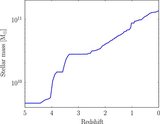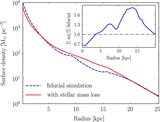Image Details

Caption: Figure 2.
Time evolution of the studied galaxy. Left: large-scale gas distribution at z = 5. The main galaxy is seen at the center; the box side is 400 kpc. Middle: evolution from z = 4 to z = 0 of the face-on i-band surface brightness, with stellar mass loss (snapshot size 50 × 50 kpc, log scale). Right: edge-on views of the i-band surface brightness at z = 0 in log scale. Each snapshot is 15 × 15 kpc, with contours at 17.25, 18.5, 19.75, and 21 mag arcsec −2. In both simulations, a spheroid is first formed by successive mergers at z > 2. A large spiral disk is built at lower redshift, both from gas found in situ and accreted from cosmic filaments and companion galaxies. Stellar mass loss supports disk survival in mergers and disk rebuilding after mergers, leading to a much lower B/D. At redshift 0, a late-type, disk-dominated Sb-Sc galaxy with a modest bulge is formed, instead of an early-type S0a-like system with a large and massive bulge and a low-mass disk.
Copyright and Terms & Conditions
© 2010. The American Astronomical Society. All rights reserved.






